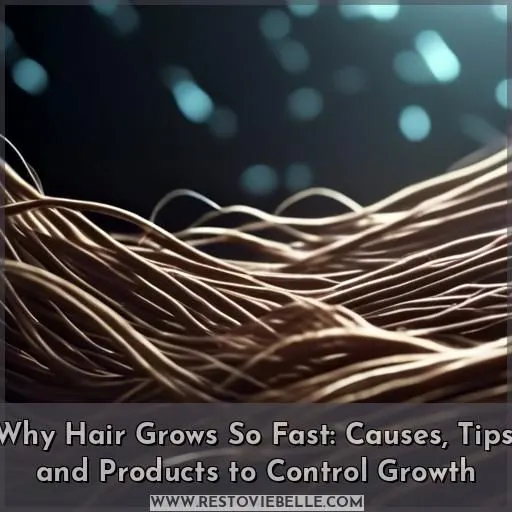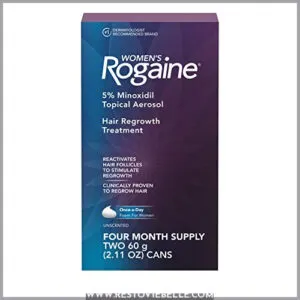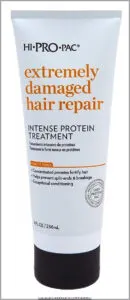This site is supported by our readers. We may earn a commission, at no cost to you, if you purchase through links.

Your hair grows rapidly due to genetic factors, hormonal imbalances like polycystic ovary syndrome (PCOS), or medications.
You may notice an abnormal spike in hair growth if your hormones are out of whack, or if excessive hair growth runs in your family.
Employing products like biotin gummies, minoxidil foam, or hair supplements can help control the growth cycle.
However, merely managing the symptoms won’t address the root cause.
To truly understand why your hair grows so fast, you’ll need to explore potential underlying conditions and treatment options.
Table Of Contents
Key Takeaways
- Genetic factors, hormonal imbalances, and medications can cause rapid hair growth.
- Hormonal imbalances can lead to excessive hair growth and may be caused by various factors such as hormonal disorders, medications, or genetic predispositions.
- Genetics play a significant role in determining hair growth rate and the health of hair follicles.
- Treatment options for excessive hair growth include hormonal therapy, birth control pills, lifestyle changes, hair growth oils, and vitamins.
Why Does Body Hair Grow Fast?
You may notice your body hair growing at an unusually rapid pace, which could be attributed to a hormonal imbalance, a genetic predisposition, or an underlying condition like polycystic ovary syndrome (PCOS). Certain medications can also stimulate excessive hair growth, so it’s imperative to determine the underlying cause to effectively manage this issue.
You Have a Hormonal Imbalance
You have a hormonal imbalance, which can be the reason why your body hair grows fast.
Hormonal imbalances can be caused by various factors, such as hormonal disorders, medications, or genetic predispositions.
For example, conditions like Cushing’s syndrome, anabolic steroid use, or thyroid issues can lead to an increase in cortisol levels, which can stimulate hair growth.
Additionally, hormonal contraceptives or hormone replacement therapy can affect the balance of hormones in the body, potentially impacting hair growth.
If you suspect a hormonal imbalance is causing your fast-growing body hair, it’s crucial to consult a medical practitioner or dermatologist for personalized advice and appropriate treatment options.
It Runs in the Family
It runs in the family: Genetics play a significant role in determining hair growth rate and the health of hair follicles.
If your family members have fast-growing or slow-growing hair, it’s likely that you’ll experience similar hair growth patterns.
This is because hair growth is influenced by genetic factors that determine the production of hormones connected to hair follicle development.
The anagen phase of the hair growth cycle, which is the most affected by genes, is responsible for hair strands pushing through the skin.
Genetics also influence hair color and texture, as well as the rate of hair growth throughout one’s life.
Hair growth rate can fluctuate with age, with the fastest growth typically occurring between 15 and 30 years old.
You May Have PCOS
If you have a hormonal imbalance, you may be experiencing rapid hair growth.
Polycystic ovary syndrome (PCOS) is a common cause of hormonal imbalances, and it can lead to excessive hair growth on the body. PCOS symptoms include irregular periods, acne, and weight gain.
PCOS treatments may involve hormonal therapy, birth control pills, or lifestyle changes such as diet and exercise.
Hair growth oils and vitamins can also help regulate hormonal imbalances and support healthy hair growth.
It’s Your Medication
Medications can substantially influence hair growth.
Certain drugs, such as retinoids, beta-blockers, antidepressants, and nonsteroidal anti-inflammatory drugs (NSAIDs), have been known to induce hair loss.
Conversely, medications like spironolactone and finasteride are employed to address hair loss.
Hormonal imbalances, such as those resulting from thyroid issues or Cushing’s syndrome, can also affect hair growth.
Stress can trigger telogen effluvium, a condition where hair prematurely enters the resting phase, resulting in hair shedding.
6 Best Products to Control Fast Body Hair Growth
For those struggling with rapid body hair growth, consider incorporating products formulated to control and slow this process. Effective options include biotin-rich hair growth gummies, carrier oils for DIY hair treatments, minoxidil foams clinically proven to reduce unwanted hair, supplements containing hair-supportive ingredients like Nutrafol’s blend, deep conditioning masks to repair damage, and shampoos with caffeine to inhibit growth.
1. Hair Growth Gummies With Biotin
- Vegan berry biotin gummies with folic acid: These gummies are vegan, gluten-free, and non-GMO, making them a great option for those with dietary restrictions. They support hair, skin, and nail health and are easy to chew.
- Hair-loving ingredients: Biotin, zinc, fo ti, vitamin B12, and folic acid are all important nutrients for maintaining healthy hair. These gummies contain high levels of these nutrients to help stimulate hair growth and maintain hair health.
- Promotes healthy hair follicles: By supporting healthy hair follicles, these gummies can help prevent hair loss and promote new hair growth.
- Easy to take: Simply take 2 gummies at any time, with or without food, to support healthy hair growth.
- Pairs well with other hair growth support products and hair vitamins: If you’re using other hair growth products, these gummies can help enhance their effectiveness.
- May cause stomach upset in some people: As with any supplement, it’s important to be aware of potential side effects. Some people may experience stomach upset when taking these gummies, so it’s best to start with a lower dose and gradually increase as needed.
Best For: Those looking for a vegan and natural way to support hair growth and overall hair health.
- Vegan, gluten-free, and non-GMO
- Contains high levels of biotin, zinc, fo ti, vitamin B12, and folic acid
- Easy to take and can be taken with or without food
- May cause stomach upset in some people
- High in biotin and vitamin B12 (10,000% of the recommended daily value)
- Can be expensive compared to other hair growth supplements
2. Pure Carrier Oils Essential Oils DIY Set
If you’re grappling with fast-growing body hair, consider the Pure Carrier Oils Essential Oils DIY Set as your secret weapon.
This set is a treasure trove for your DIY beauty arsenal, offering nourishing and anti-aging benefits that can tame even the wildest of manes.
Imagine your skin and hair soaking up the deep moisture from these oils, leaving you with a smooth and glowing appearance. It’s like giving your body a drink of the good stuff!
Plus, with the generous size of the castor oil bottle, you’ve got a veritable fountain of youth at your fingertips.
Best For: DIY essential oil blends, nourishing skin and hair care, and promoting smooth and glowing hair.
- Nourishing and anti-aging benefits
- Deeply moisturizes skin and hair
- Great value for the price
- Oils may have a slight oily residue
- Almond oil may have a faint essential oil scent
- Castor oil bottle is larger than the others (8 oz. vs. 4 oz.)
3. Rogaine Women’s 5 Percent Minoxidil Foam
Rogaine Women’s 5 Percent Minoxidil Foam is a topical hair loss treatment for women that contains 5% minoxidil, a medication known for promoting hair regrowth.
The foam is unscented and designed to be applied once a day to the scalp.
Minoxidil works by stimulating hair growth, improving blood flow around the hair follicle, and encouraging the hair follicle to grow hair.
It’s clinically proven to regrow hair that’s 48% thicker.
The foam formulation is also suitable for female pattern hair loss or thinning.
Best For: Women experiencing hereditary hair loss and thinning.
- Clinically proven to regrow hair 48% thicker.
- Reactivates hair growth cycle.
- Conditions and exfoliates scalp.
- Can cause scalp irritation in some users.
- Requires consistent use over several months for results.
- Not suitable for everyone, consult a doctor before use.
4. Nutrafol Women’s Hair Growth Supplements
Nutrafol Women’s Hair Growth Supplements are designed to target the root causes of hair thinning in women aged 18-44. These supplements contain a blend of 21 powerful ingredients, including Ashwagandha, which helps lower cortisol levels and improve stress resistance. Biocurcumin, extracted from turmeric, is a potent antioxidant that fights inflammation and supports hair growth. Tocotrienols, a form of vitamin E, protect hair follicles from oxidative damage. Hydrolyzed Marine Collagen promotes healthy hair growth and scalp elasticity.
In a clinical study, 80% of women saw improvement in hair growth after using Nutrafol Women’s Hair Growth Supplements. The supplements also help improve hair quality, leading to better strength, shine, texture, density, manageability, and faster hair growth. Nutrafol is formulated with high-potency extractions that have been clinically proven to outperform traditional doses. It’s physician-formulated to multi-target root causes that compromise hair health.
Nutrafol Women’s Hair Growth Supplements are made with ethically sourced plant extracts in standardized dosages to achieve hair growth without the use of drugs. They’re free of most common allergens and unnatural stuff like GMOs, soy, eggs, dairy, gluten, milk, peanuts, shellfish, tree nuts, wheat, yeast, artificial flavors, or artificial colors.
Best For: Women ages 18-44 looking to target the root causes of hair thinning and improve hair growth.
- Science-backed ingredients
- Results visible in 3-6 months
- Improves hair overall, reduces shedding, and strengthens nails
- Capsules are large and require taking 4 daily
- Results may take up to 90 days to appear
- Cost is high for long-term use
5. Extremely Damaged Hair Repair Treatment
If you’re dealing with extremely damaged hair, it’s time to repair and restore its strength. Hi-Pro-Pac’s Extremely Damaged Hair Repair Intense Protein Treatment is a 2-5 minute solution for your hair woes. This intense protein treatment is designed to treat and correct excessively damaged hair, improving strength and preventing breakage. The concentrated proteins and active moisturizers work together to fortify your hair, preventing split ends and breakage.
To use, simply shampoo and rinse your hair, then apply the desired amount of conditioner to your hair, massaging it through to the ends. Leave it on for 2-5 minutes before rinsing thoroughly and styling your hair. This treatment is perfect for those with over-processed, dry, or damaged hair, providing exceptional conditioning to improve manageability and prevent further damage.
With positive customer reviews, this Hi-Pro-Pac product leaves hair feeling soft, silky, and smelling good, giving the impression of a salon treatment. It’s also great for curly hair as a deep conditioner. So, if you’re looking for a quick and effective way to restore your damaged hair, give Hi-Pro-Pac’s Extremely Damaged Hair Repair Intense Protein Treatment a try.
Best For: Extremely damaged hair in need of repair and restoration.
- Quick and effective 2-5 minute treatment
- Fortifies hair with concentrated proteins and active moisturizers
- Improves manageability and prevents further damage
6. Alpecin C1 Caffeine Hair Growth Shampoo
Alpecin C1 Caffeine Hair Growth Shampoo claims to promote natural hair growth, thicken and strengthen hair, and energize hair strands with its caffeine and castor oil formula.
It is designed to be used daily for best results and is infused with a Caffeine Complex containing caffeine, zinc, and niacin.
This complex helps cleanse the hair and scalp, enabling natural hair growth from the root.
The shampoo is suitable for all men and is clinically proven to be effective.
It is recommended to massage the shampoo into the hair and scalp, leave it on for two minutes, and rinse it out.
The shampoo is also free of silicone, which can improve the hair structure and make it easier to style without the use of softening agents.
Best For: Men looking to promote hair growth and prevent hair loss.
- Promotes natural hair growth
- Thickens and strengthens hair
- Energizes and recharges hair strands with caffeine and castor oil
- May cause scalp irritation
- May not be effective for all hair loss cases
- Requires daily use for best results
How to Slow Body Hair Growth
You can invest in a better shave by using high-quality razors, shaving creams or gels, and properly preparing your skin for a close, comfortable shave.
Alternatively, you may consider laser hair removal, which provides a more long-term solution for reducing unwanted hair growth by damaging the hair follicles and preventing future growth.
However, it’s essential to get to the underlying cause of excessive hair growth, whether it’s hormonal imbalances, genetics, or medications, and address those underlying factors for effective long-term management.
Invest in a Better Shave
Investing in a better shave isn’t just about ditching the fuzz; it’s an art form that respects your skin’s needs and tames the wild growth. Here’s how:
- Skin Preparation: Warm water and gentle exfoliation prep the canvas.
- Shaving Technique: Use a sharp, high-quality razor with precision.
- Shaving Cream: Choose one that soothes and protects.
- Aftershave Routine: Hydrate and calm with a nourishing aftershave.
Mastering these steps can slow the sprint of body hair growth, leaving your skin smoother for longer.
Consider Laser Hair Removal
Consider laser hair removal as a long-term solution for slowing down the growth of unwanted body hair.
It works by damaging the hair follicles, putting them into a state of dormancy for an extended period.
Although it’s not a permanent solution, it can markedly reduce the number of unwanted hairs in a given area.
For best results, it’s recommended to undergo multiple treatment sessions spaced six weeks apart, with most people needing between four and six sessions.
After the initial treatment cycle, occasional maintenance sessions may be required to prevent hair follicles from regenerating.
However, it’s crucial to consult a board-certified dermatologist for professional laser hair removal to ensure safety and effectiveness.
At-home laser hair removal devices may not be as advanced or appropriate for all skin types and colors.
Get to the Root of It
To decelerate body hair growth, it’s crucial to confront the underlying cause.
Genetics play a pivotal role, but you can impact hair follicle development through diet and stress management.
Ingest a balanced diet rich in protein, vitamins, and minerals to foster healthy hair growth.
Manage stress to prevent premature entry into the telogen stage, which can result in hair shedding.
Additionally, consider using hair supplements and hair care products that promote hair health.
Body Hair Maintenance Tips
To maintain your body hair and prevent excessive growth, you should avoid overwaxing or shaving too frequently, as this can stimulate the hair follicles and lead to thicker, coarser hair. Additionally, regular exfoliation helps remove dead skin cells and ingrown hairs, while moisturizing after hair removal can soothe irritation and prevent dryness, which can contribute to faster regrowth.
Avoid Over-Waxing or Shaving
Avoid over-waxing or shaving to prevent skin irritation, razor burn, and follicle damage. Opt for a better shave with a sharp razor, lubricating strip, and proper technique. Consider microneedling to stimulate collagen production and improve skin texture.
Exfoliate Regularly
Regular exfoliation is a vital step in maintaining healthy skin and fostering hair growth. Exfoliation methods can differ, and the ideal frequency depends on your skin type and the exfoliation technique you select. For sensitive skin, mild chemical exfoliants are often the preferred choice, as they’re less likely to induce irritation than physical exfoliators such as scrubs.
When it comes to exfoliating your scalp, the advantages extend beyond controlling hair growth. Scalp exfoliation can enhance skin tone and texture, boost collagen production, reduce blemishes, and brighten your skin. It also aids in unclogging the tissues, creating a suitable environment for healthy hair follicles to thrive.
For sensitive skin, it’s imperative to begin with a short-contact formula, such as a cleanser or rinse-off mask, to minimize the likelihood of irritation. Additionally, avoid exfoliators with fragrance, as they can be a common skin irritant.
Exfoliating products for sensitive skin should contain gentle ingredients such as salicylic acid, glycolic acid, polyhydroxy acid, and lactic acid. Polyhydroxy acids are particularly well-suited for sensitive skin, as they’re less likely to cause irritation compared to other acids.
Moisturize After Hair Removal
After hair removal, it’s crucial to moisturize your skin to maintain its softness and hydration. Here are three simple steps to follow:
- Select the Appropriate Moisturizer: Choose a gentle, fragrance-free moisturizer tailored to your skin type. If you have dry skin, consider a rich cream or lotion. For oily skin, opt for a lightweight gel or serum.
- Apply Regularly: Apply the moisturizer to the treated area daily, preferably after a shower or bath when your skin is still moist.
- Protect Your Skin: In the hours following hair removal, avoid direct sun exposure as your skin is more vulnerable to UV radiation. Always use sun protection to shield your skin from sunburn and hyperpigmentation.
When to See a Dermatologist
If you’re experiencing unusual hair growth or hair loss, it’s essential to consult a dermatologist.
Hair loss can be a symptom of medical conditions like alopecia areata or trichotillomania.
Excessive hair growth may indicate hormonal imbalances or the use of certain medications.
Hair removal techniques and hair care products can also cause issues.
In the table below, we’ll explore when to see a dermatologist based on your concerns.
Conclusion
Ultimately, if your excessive body hair growth persists despite utilizing products and grooming techniques, it’s essential to consult a dermatologist.
They can pinpoint the underlying cause, whether it’s a hormonal imbalance, genetic predisposition, or an undiagnosed condition like PCOS.
They can recommend appropriate treatment options.
By addressing why your hair grows so fast at the root level, you can effectively manage and control unwanted hair growth.














